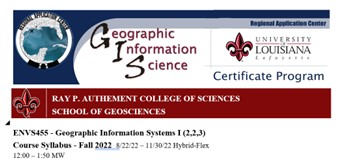University of Louisiana at Lafayette
Physical and chemical principles and processes as they relate to the environment.
- Teacher: Tyrell Lassair
Write a concise and interesting paragraph here that explains what this course is aboutEnvironmental science is a group of sciences that attempt to explain how life on Earth is sustained, the causes of environmental problems, and how these problems can be solved. The study of environmental problems and their solutions have never been more important… A comprehensive survey of critical issues in environmental science focusing on the following topics will be covered in this course: human population; the global chemical cycles; ecosystems and biodiversity; endangered species and biodiversity; sustainable agriculture and the environment; energy systems from fossil fuels to renewable forms; water and soil resources; Earth’s atmosphere and climate change; urban environments; waste managment; and paths to a sustainable future.
- Teacher: Alessia Corami
- Teacher: Sadia Islam
- Teacher: Anna Paltseva
Environmental sciences based on the interdependent natural systems which support life on earth.
- Teacher: Alessia Corami
- Teacher: Durga Poudel
Formation, distribution and classification of soils as natural bodies.
- Teacher: Durga Poudel
Environmental pedology is a study of soils (soil genesis, soil morphology, and soil classification) in relation to soil water, soil chemical processes, soil risks and hazards, and soil landscape analyses. These topics require field assessment of soil morphology and composition. Remote sensing technology, digitally-linked geographic data, and powerful computer-driven geographic information systems have been exploited in recent years to extend pedological applications beyond traditional field-based reconnaissance. New research developments such as oceanic pedology, engineered soils, urban pedogenesis, volcanopedogenesis, soil of polar cities and more will be discussed in this course. Environmental pedology course includes 2 lecture hours per week and 2 laboratory hours per week.
- Teacher: Eden Maier
- Teacher: Anna Paltseva

This course begins your development into the world of computer mapping technology and provides an overview of the theory and general principles underlying geographic information systems (GIS). The lecture portion of this course is designed to help students understand the fundamental knowledge about GIS and develop skills in practical problem solving where the technology of GIS can be implemented, while the laboratory component of this course is to complement the lecture materials and to provide students with a first look into the practical experience of solving real-world environmental problems with GIS.
Through this course, students will understand: (a) how spatial information is stored and georeferenced in GIS, (b) what are map projections and coordinate systems, (c) how to create maps in a commercial software package, and (d) how to process and analyze geographic information stored vector formats while introducing raster formats. All students must complete a final map to demonstrate GIS applications.
Through this course, students will understand: (a) how spatial information is stored and georeferenced in GIS, (b) what are map projections and coordinate systems, (c) how to create maps in a commercial software package, and (d) how to process and analyze geographic information stored vector formats while introducing raster formats. All students must complete a final map to demonstrate GIS applications.
- Teacher: Courtney Chicola
- Teacher: Rodney Yantis
Soil is fundamental of ecosystem and is essential for life; it is a dynamic yet finite resource at the surface of our planet. This course is designed to augment the principles of soil science in an urban environment. You will learn soil physical and chemical properties, formation and hydrology of soils, soil ecology and biology, soil management, and urban soil contamination. Hands on activities, field work, and interactive discussions are the essentials of this course, which includes 3 lecture hours per week and 2 laboratory hours every week
- Teacher: Caitlin deNux
- Teacher: Eden Maier
- Teacher: Anna Paltseva
Scientific principles of growth, reproduction, commercial usage, and environmental impact of plants.
- Teacher: Alessia Corami
- Teacher: Katherine Eddings
Adv GIS Analysis&Applications
- Teacher: Courtney Chicola
- Teacher: Rodney Yantis
